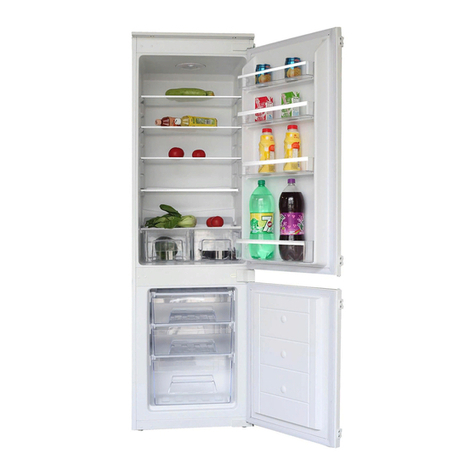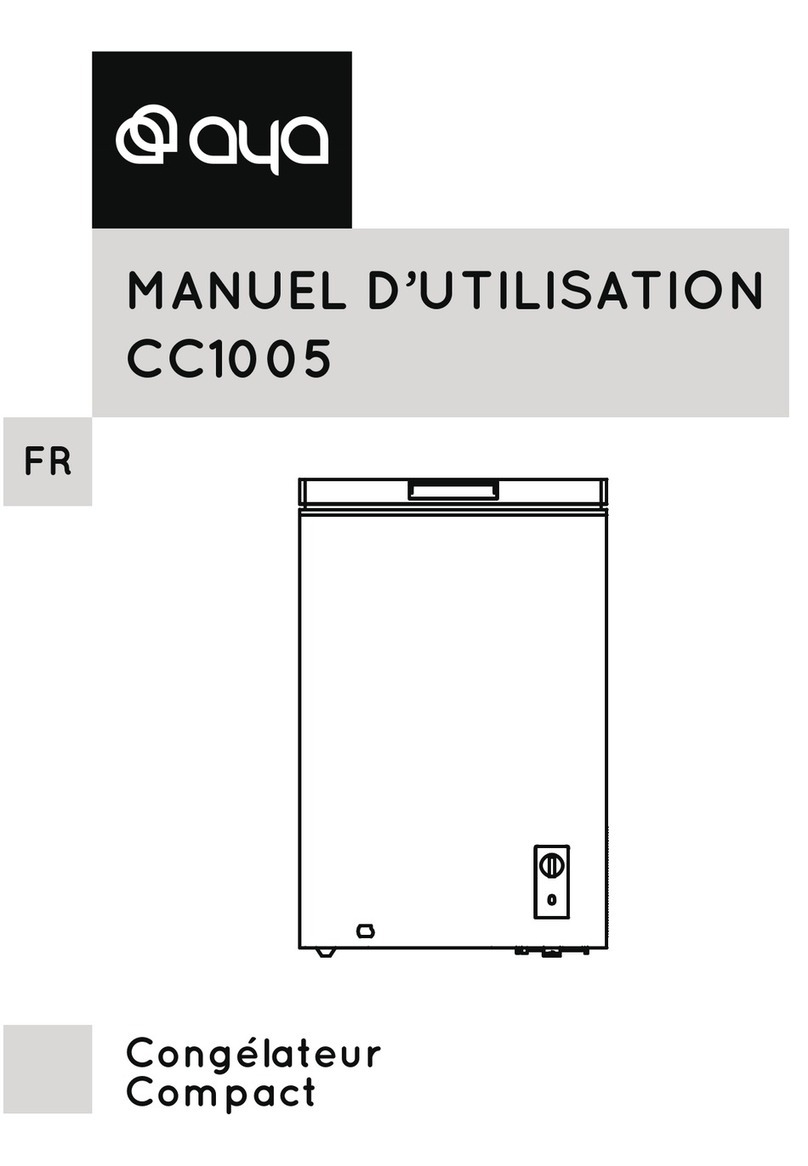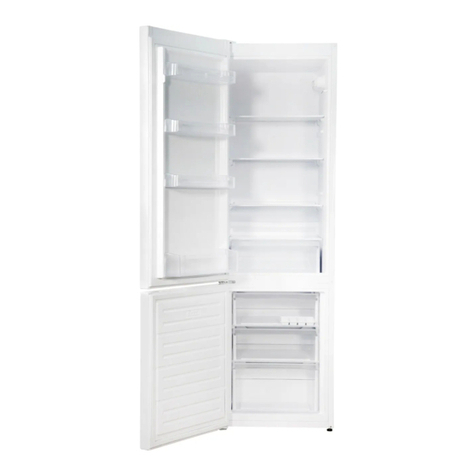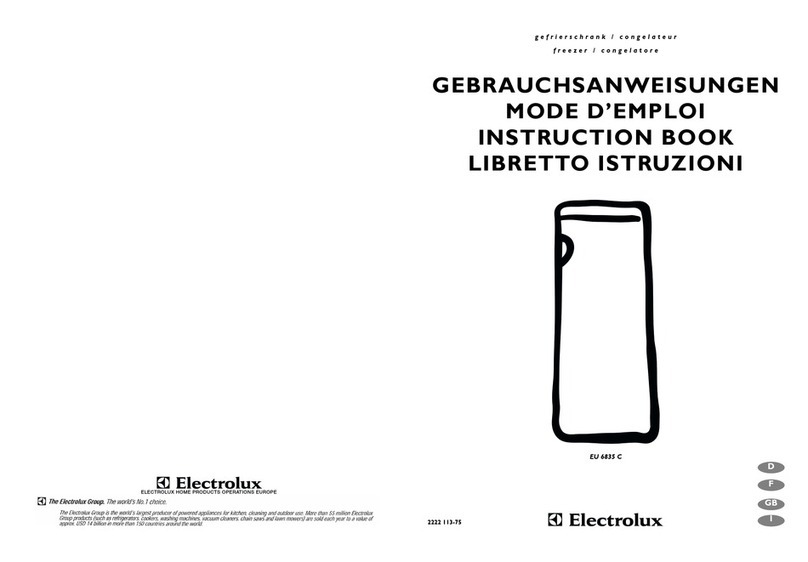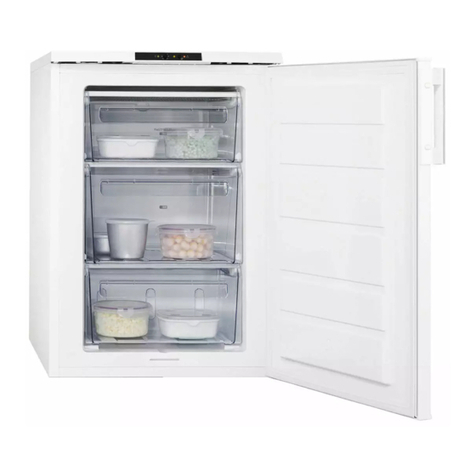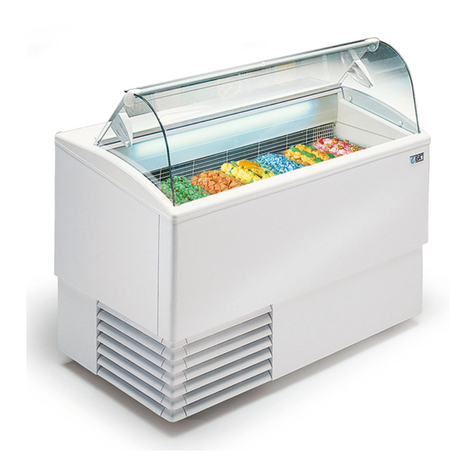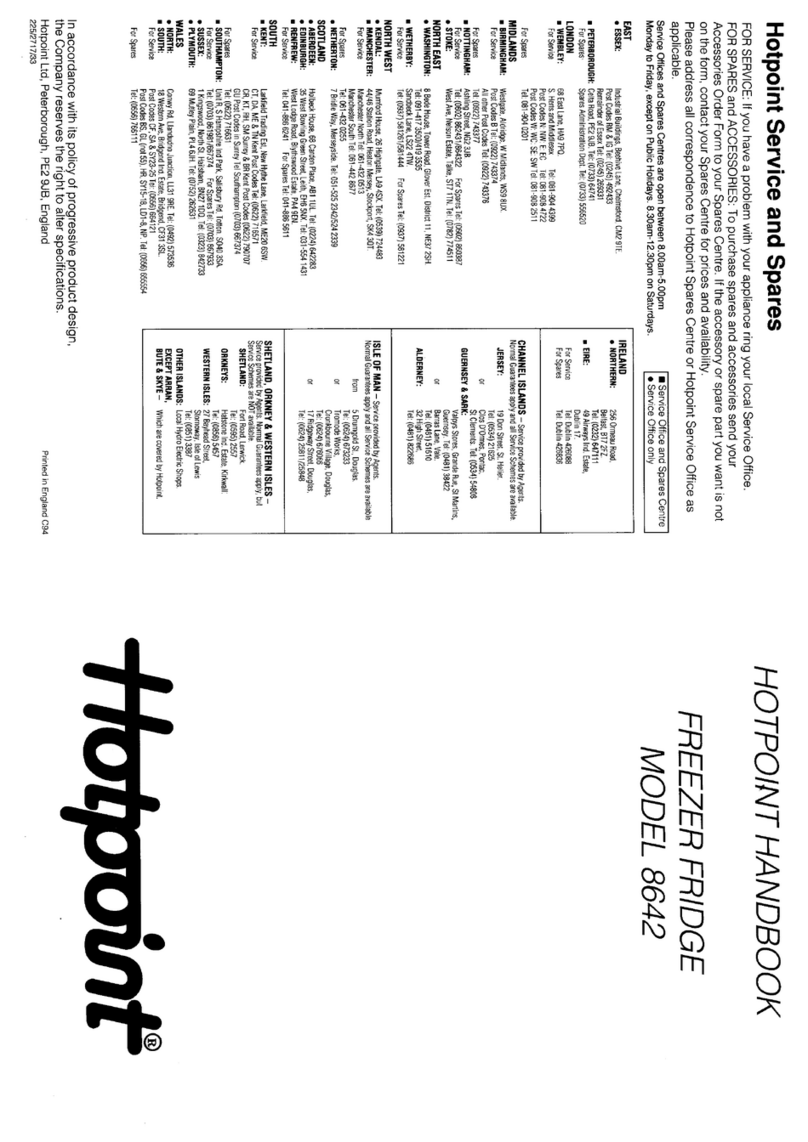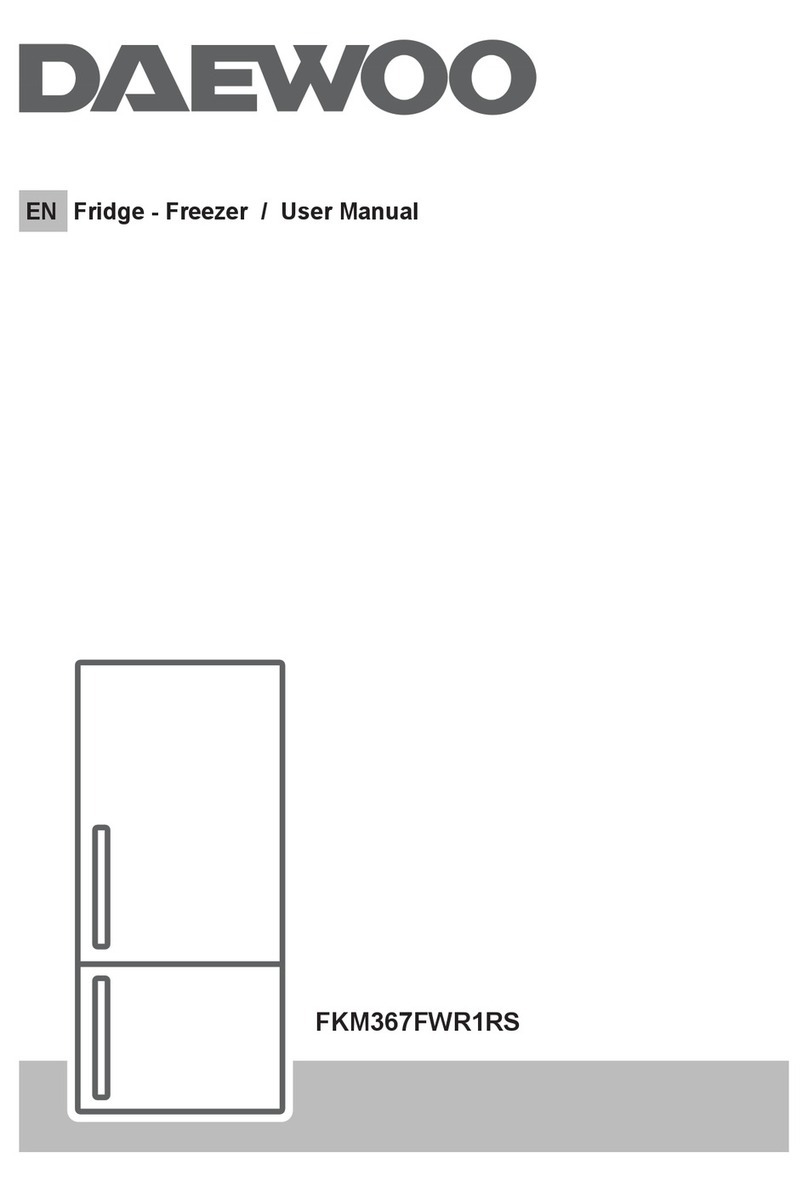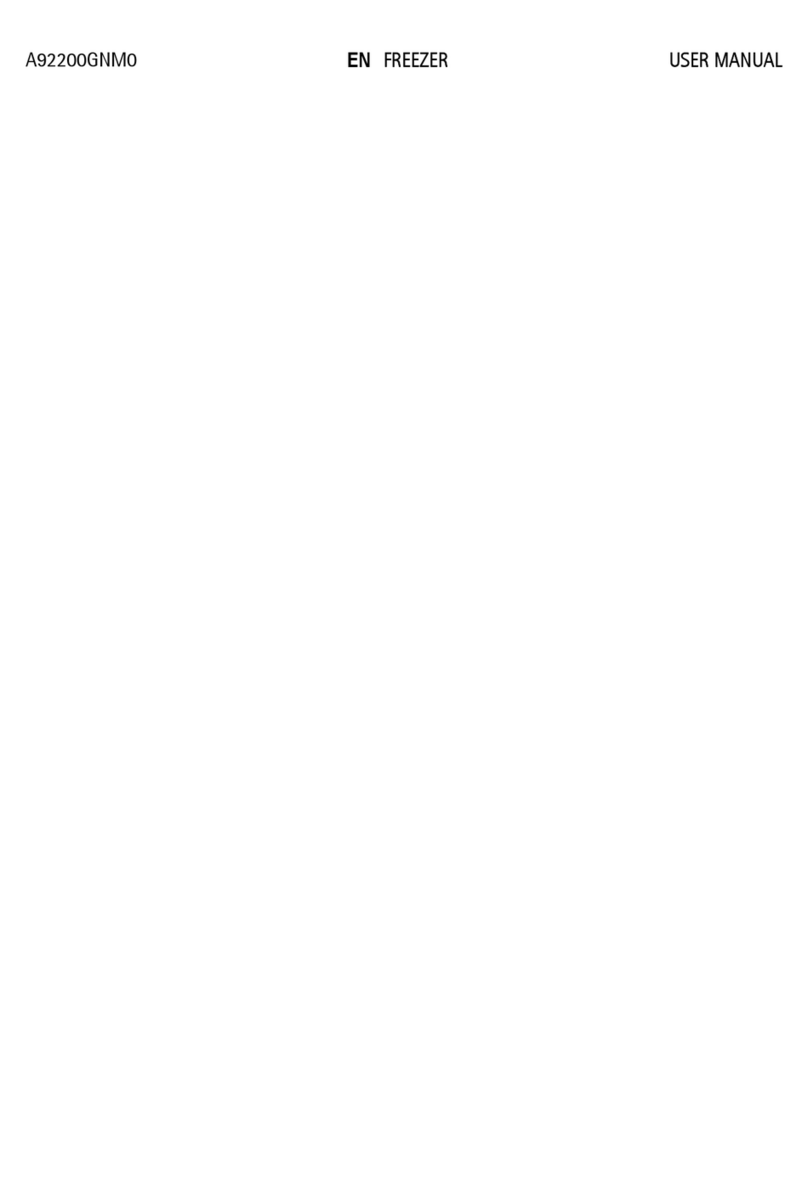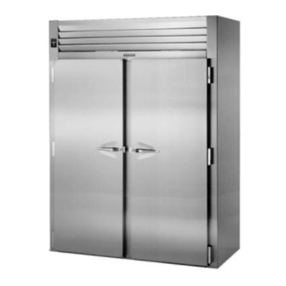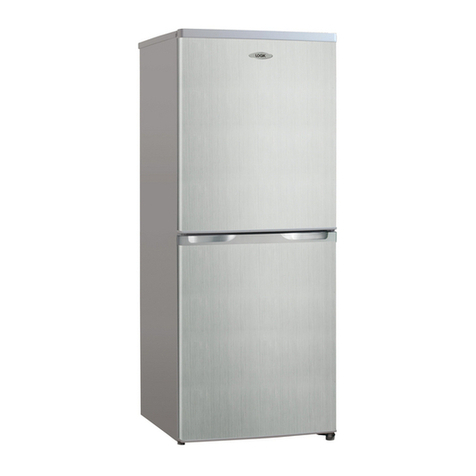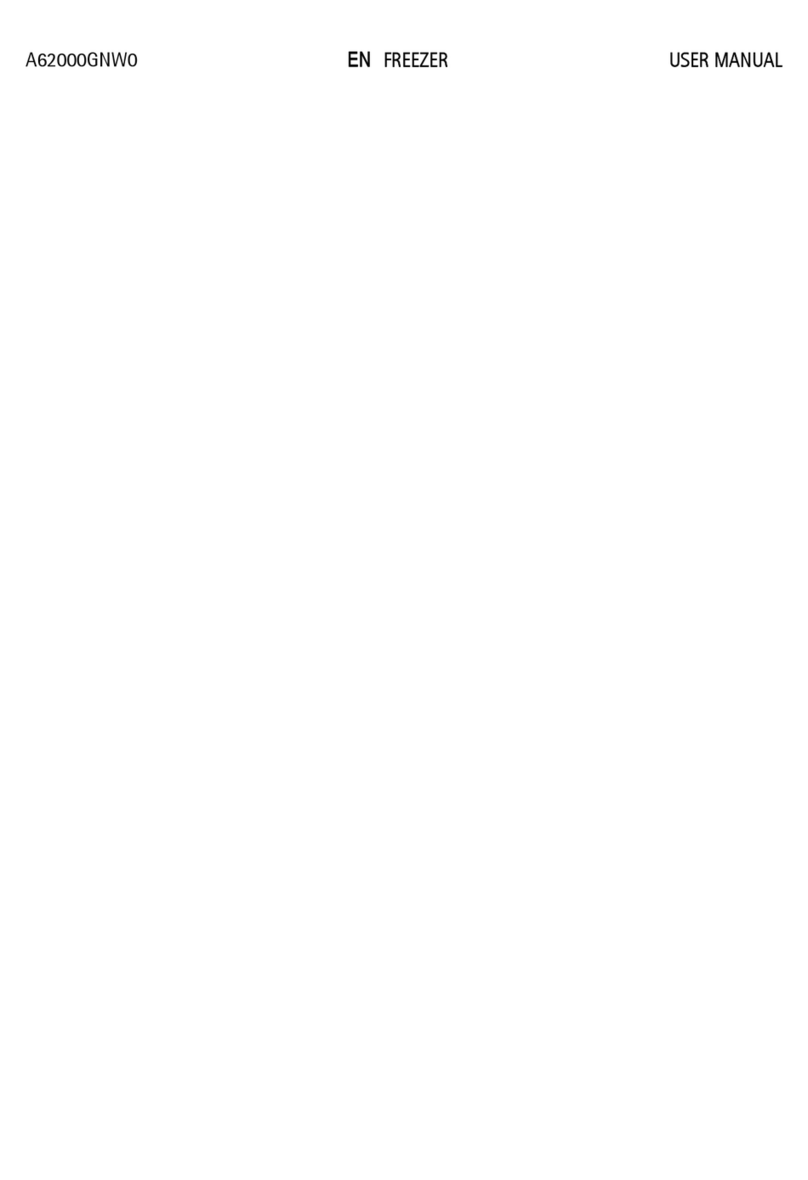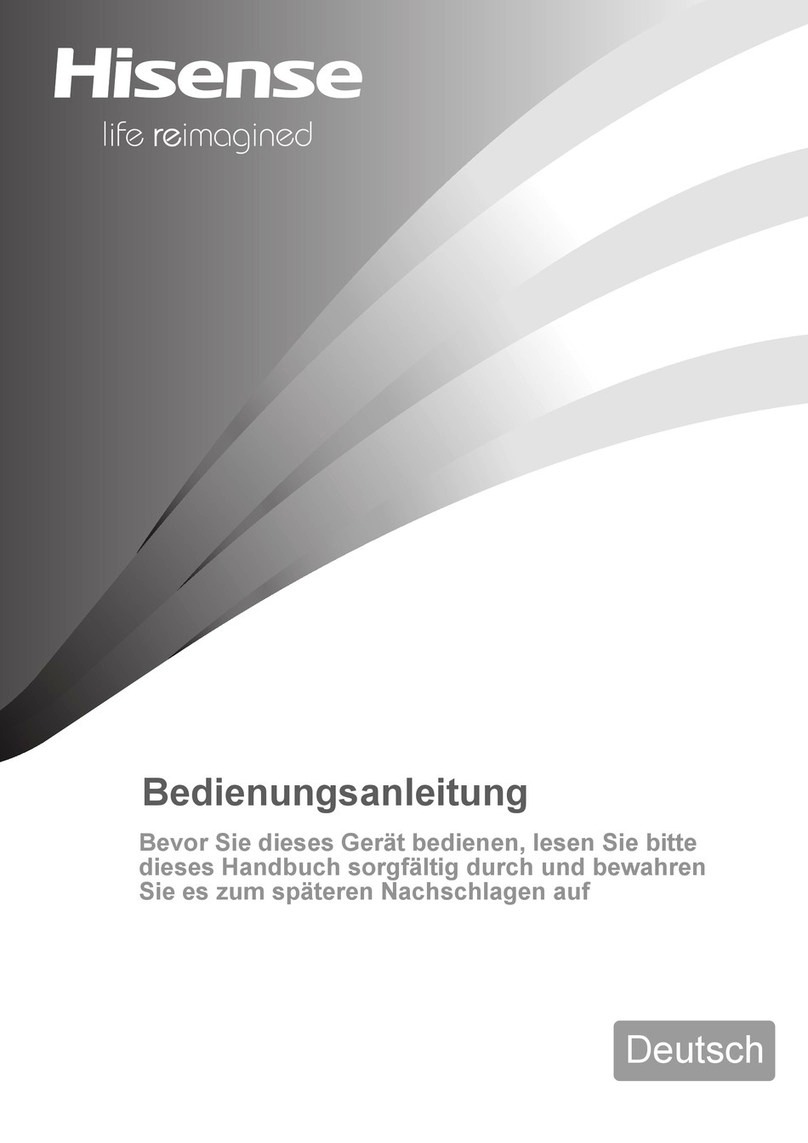SIA RFI108 User manual

SIA
Freezer
Instruction Manual
MODEL RFI108
Built in
Before use, please read and follow all the safety rules and operating
instructions.

European Safety Certificate
Compliance Declaration
The manufacturer assumes full responsibility for the compliance
of products manufactured with relevant safety, health and
environmental protection requirements set out in European
Directives. Test reports are available for verification upon
request. The manufacturer will present the quality certificate or
manufacture license to a refrigerator dealer if so required.
Furthermore, the manufacturer declares that all parts intended
to be in contact with fresh food as described in this User’s
Manual are free of toxic substances.
The symbol on the product or on i ts
packaging indicates that this product may
not be treated as household was te. Instead
it shall be handed over to the applicable
collection point for the recycling of electrical
and electronic equipm ent. By ensuring this
product is disposed of correctly, you will
help prevent potential nagetive
consequences for the environment and
human health, which could otherwise be
caused by inappropriate waste handling of
this product. For more detailed information
about recycling of this product, please
contact your local city office, your
household waste dispos al ser vice or the
shop where you purchased the product.

C
ontent Page
1. Environmental Protection and Proper Disposal.........2
2. Location.....................................................................2
3. Installation ....................................... . .....................2-3
4. Rating Plate........................................................... ...3
5. Electric Connection ...................................................3
6. Operation Instructions... .........................................3-4
7. Freezer Compartment ...............................................4
8. Ice & Ice Cream Making ...........................................5
9. Preparing for Vacation .............................................5
10.Cleaning & Maintenance .........................................5
11.Defrosting .................................................... ..........5-6
12.Problem Diagnosis ..................................................6
13.Troubleshooting ................................ .....................6-7
14.During a Power Interruption.....................................7
15.Making A Service Call .............................................7
16.Installation In Kitchen ..............................................7
17.Warranty..................................................................7
18.Illustration of Parts...................................................7
Please read these instructi ons carefull y before use.
Underline the importa nt in structions. Ke ep the User ’s
Manual i n a s afe pl ace for l ater refere nce. Remem ber to
hand it over to the owner, if you ever sell the appliance.
What you hav e boug ht is a safe and reli able refrigerator.
With appropriate use and maintenance, it will be in service
for years. T he last page of th is User’s Ma nual sets out
specifications of this appl iance and the per formance dat a
indicated in the rating plate are test results obtained at an
ambient temperature range of 16~32°C.
Important!
It is intended strictly for household use. If using it for
industrial or commercial purpose, be sure to observe the
relevant norms and regulations.
A leakage test has been conducted in accordance with
relevant safety standard.
To avoid the risk of child entrapment, please make sure
your old refrigerator is inoperative and safe by removing
the latches and bolt locks before disposal.
Important!
It must be noticed that re frigeration s ystem contains
refrigerants, which req uire specia lized waste dispos al.
Contact your local waste dispos al ce nter for prop er
disposal of a n old ap pliance and cont act your loc al
authority or your deal er if you have an y question. Pleas e
ensure that the pipe work of y our refrigerator does not get
damaged prior to bein g pick ed up by the r elevant waste
disposal ce nter, and co ntribute to enviro nmental
awareness by insistin g o n an a ppropriate, anti-po llution
method of dis posal. Pl ease see the r ating plate for th e
type of refrigerant and insulation used.
The plug sh ould be acc essible after the app liance is
positioned.
If the po wer c ord is damag ed, it must be replac ed with a
new p ower c ord from the manufactur er or an auth orized
service agent.
Caution:
The appliance should be installed in a well ventilated place.
The shipment package should be removed.
Caution:
Do not use a sharp or pointed item to defrost.
Caution:
Make sure the refrigeration system is not damaged.
Caution:
Do not us e el ectrical a ppliances ins ide th e food stor age
compartments of the app liance, other than model s
recommended by the manufacturer.
This User’s Manu al is appl icable to a vari ety of models
and th ere m ay be sl ight c hanges in c ertain aspects from
model to model.
1

1.Environmental Protection and
Proper Disposal
Package materials
The applianc e is packag ed in a way to prev ent damag es
during transportation. Recyclable materials are used.
The packing box is made of corrugated board / cardb oard
(mainly from recycled paper).
·Polystyrene parts (CFC-free foamed polystyrene)
·Linings and polyethylene bags
·Polypropylene straps
All thes e va luable materi als ma y be take n to a waste
collecting center and used a gain after ade quate recycling.
All waste materials should be disposed properly.
2.Location
Make sure the refrigerator is kept uprig ht during han dling.
If an incl ination is r equired, it shou ld not e xceed 45
degrees. Other wise the a ppliance ma y get dama ged
resulting n ot onl y i n compromised refrigeration
performance.
To avoid product dama ge or person al injur y, the
refrigerator should be unpacked by t wo persons after it is
located in a previously selected position.
Before i nstallation, make su re the r efrigerator has no
visible exterior damage.
When handling the refriger ator, do not lift it by holding the
worktop, to prevent any damage to the refrigerator.
Do not start up a refrigerator that is damaged.
Check the refrigerator carefully for:
·Damaged package due to inappropriate handling
during transportation
Damage in the exterior
·Damage in power cord / plug
Any d oubt, please co ntact Customer Service for a
thorough checkup of the appliance.
Take necessar y me asures to prevent leakag e of
refrigerant at the start-up of re frigerator that ma y result in
environmental pollution.
3.Installation
a) Remove all package materials.
b) Remove items in the refrigerator.
c) Make sure to remove film and tape on the cabinet and
the door.
d) Remov e polystyrene c hips (if a ny) aroun d the
refrigerator.
e) Take out accessories and literature in the refrigerator.
f) Clean the inside of the refrigerator with luke warm
water and vinegar and then dry it with a soft cloth.
g) Use the spanners supplied to adjust the leveling leg to
ensure the refrigerator is stable.
Do not use detergents, sharp or pointed instruments
or soda-based cleansers to clean the refrigerator.
· Before installation, make sure the refrige ration s ystem
is free of any damage.
· The refrigerator should be used for its intended purpose
only.
· The refriger ator shoul d be position ed on the solid and
even floor to ensure refrigera nt circul ation an d
refrigerating performance.
· If possibl e, positio n the re frigerator in a cool an d dr y
well ventilated room.
· Do not e xpose the refrig erator to direct sunshi ne a nd
make sure the ambient tem perature is not extremel y
high.
· Keep the refrigerat or from a heat sou rce, such as
heating s ystem, oven or cookers. Ot herwise the
compressor will op erate mor e freque ntly resultin g in
extra power consumption.
If the refrigerator will be p laced near a h eat source, it is
recommended to install a t hermal barrier bet ween the
refrigerator and the heat source (asbestos is prohibited) or
maintain adequate space between the refrigerator and
the heat source as follows:
Do not place a ny radiating apparatus, such as micro wave
oven or roaster, on top of the refrigerator.
Make sure the air vent is not obstructed.
Never unplug the refrigerator by pulling on the power cord.
Always grip the plug firmly and pull it strai ght out from the
outlet.
2
the heat source as follows:
Cooker or electric stove 3 cm
Radiator or oven 30 cm
Another refrigerator 2 cm

Warning!
After the refrigerator is positioned, allow it to stand still for
at least 2 hours before starting it up to ensure stable
refrigerant circulation and faultless operation.
Before starting up the refrigerator, make sure the inner
compartment is dry (especially corners).
Danger!
Depending on the chemical composition, the refrigerant
may be flammable. The leak-proofness of refrigerant
circulation system is test proven. Unauthorized
intervention of the refrigerant circulation system may
cause fire.
Make sure the refrigerant circulation system and the
peripheral parts of compressor are not affected.
Any intervention of the refrigerating system should be
conducted only by professional personnel.
Warning!
Refrigerant get ting into e yes can caus e seri ous inj ury. In
this case, rins e the e yes under running water and c onsult
an ophthalmologist without delay.
The refrigerator shoul d be used within an appr opriate
range of room temperature by its climate type.
The range of r oom temperature for a sp ecific climate t ype
should be observed. See th e ra ting p late for the climate
type of your appliance.
Climate type Room temperature
SN +10°C~+32°C
N +16°C~+32°C
ST +18°C~+38°C
T +18°C~+43°C
4. Rating Plate
A rating p late i s found on the side p anel or back p anel of
the refrigerator, indicating important technical data.
Write down these technical data.
Write down these technical data.
Write down the technical data for later reference to avoid
the need for moving the refrigerator when such data are
needed.
Model / Type
Storage............................................................... Liter
Working voltage…………………………………… Volt Max
input power (W) ……………………………… Watt
Current……………………………………………... Amp
Energy consumption …………………………….. kWH/24hr
Freezing capacity ………………….. kg/24hr
5.Electric Connection
The refrigerator should use a properly grounded outlet
which should be checked by a qualified electrician. The
refrigerator should always be plugged into its own
individual electrical outlet which has a voltage rating and a
fuse rating in conformity with the rating plate.
In case of nonconformity, consult the local service center
or the dealer immediately.
The refrigerator should not be connected with a converter
(such as solar cell)
Do not use an extension cord.
6.Operation instructions
a)Power on the refrigerator (or power off), and select
temperature settings
· Temperature regulator (thermostat)
· Temperature regulator is used to power on/off the
refrigerator, and select temperature settings.
b).Startup
Turn the temperature regulator clockwise to startup the
refrigerator. (Turn to restricted position at most, or you
may break the temperature regulator).
Compressor starts operation, till interior temperature
satisfies the settings.
c). Setting temperature
In order to adjust the setting of temperature regulator of
freezer compartment, use the key supplied by the
manufacturer and turn the temperature regulator clockwise
or anticlockwise to a desired setting.
3

To select a lower temperature: Turn clockwise
To select a higher temperature: Turn anti-clockwise
Turn temperature regulator counterclockwise to the lo west
setting=lightest cooling;
(Turn the reg ulator c ounterclockwise to the most will
power off the refrigerator, compressor will stop)
Turn temperature regul ator countercl ockwise to the
highest setting=coldest setting;
Temperature setting sh ould conform to the follo wing
conditions:
· Ambient temperature;
· Quantity of food stored;
· Door openings;
Through obs ervation, you’ll soon l earn ho w to select a n
appropriate temperature setting.
Appropriate temperature setting is v ery imp ortant for foo d
storing. Microbes can get food spoiled very quickly, unless
there growth is sprouted b y low temperature environment.
It is recommended to set the temperature to 18°C or lower
which ma y effectively eliminate food spoil ing process b y
microbes.
d).Stopping
Turn temperature regulator counterclockwise to the most.
The compressor should stop by then.
Unplug from wall outlet.
7.Freezer compartment
3-star or 4-star freezer are suitable for storing deep frozen
food (alre ady frozen befor e added to the freezer), storing
fresh food for a short period (2-3 weeks) by freezing it, or
making ice, ice cream and water ice.
Recommended expiration date of food must be observed.
Freezer can be used to produce ice cubes.
1.Temperature within the fr eezer ca n be adjuste d b y
setting temper ature regu lator. F or fresh fo od and foo d
which needs to be stored for a long period, -18°C or below
is recomme nded, as micr obes can barely survive u nder
this temperatur e. Once tem perature is highe r than -10°C,
microbes will start to caus e spoil ing of food, and storage
period of foo d will b e effecti vely red uced. If you n eed to
freeze foo d which is alr eady partly or t otally tha wed,
please co ok it before adding it to the freez er ag ain. T he
high temper ature of co oking process c an eliminate most
microbes.
2 The higher the temperatu re regulator is set, the lo wer
the temperature within the freezer will be.
3 Normall y, w hen fo od re quires o nly s hort perio d of
storage, select a medium setting.
4 Norma lly, when food requires a long period of stor age,
select a high setting.
NOTE!
· Never add caned or bottled carbon dioxide drinks to the
freezer, as carbon di oxide ma y e xpand w hen u nder
freezing, and lead to explosion hazard.
· Bottled food which needs immediate cooling sho uld be
stored in the fr eezer for no more than o ne hour before
they’re taken out, otherwise bottles may burst.
· Ice cream or water ice shou ld b e a llowed sev eral
minutes b efore usin g, as li ps and to ngue ma y get
frostbite (chap ma y occ ur in skin). Mean while, av oid
touching inner walls of freezer with wet hands.
IMPORTANT!
· Food to be added to freezer must be well wrapped.
· Observe expiration date of frozen food.
· Only fresh food i n hig h qu ality is suitab le for freezing
storage.
· Food stored in freezer should be properly sized.
· Weight of a singl e packa ge of frozen fo od sho uld not
exceed 2 kg.
· Please use reusab le pl astic film, aluminum film for
packing food, or put food in containers.
· Food packages should not entrap too much air inside.
· Use bunge e, clip, rope o r freezing-resistant tape for
sealing of food package.
· F ilm welding devic e can be use d to se al the p lastic
packages.
· Place the wide s ide of food package downward to
obtain a faster freezing process.
· W ipe the packa ges dr y before ad ding them to the
freezer, as they may stick together when frozen.
· If you ne ed to freeze foo d which is alr eady partl y or
totally tha wed, pleas e cook i t before ad ding it to the
freezer again.
· Don’t use f ood which is a lready expired, as the y m ay
cause poisoning.
4

8.Making ice cubes, ice cream and
water ice
Making ice cubes:
· Add water to ice tray to 3/4 of its volume, place it at the
bottom area of the freezer. When ice cube s are read y,
flush the ice t ray with r unning water, the n, you c an
easily take out the ice cubes.
Making ice cream:
· Remove se parators of th e ice tra y. Pl ease n ote the
creamier your ice cream is, the long er it w ill take to
make it. When ice cream is ready, flush the ice tray with
running water, then, you ca n easil y take out the ice
cream.
9.Preparing for Vacation
For long vacati on or absenc e, unplu g the refrigerator a nd
clean the refr igerator as d escribed i n “ Cleaning a nd
Maintenance”. Leave the do ors open to pre vent formation
of mildew or odor.
10. Cleaning and Maintenance
Unplug or disconnect the appliance before cleaning.
Keep the outsi de clea n. Use furn iture po lisher or finishing
conditioner to clean the outside regularly (do not use these
cleaners to cle an the i nside). Wipe the d oor gasket with a
cloth lightly dampened with lukewarm water. No det ergent
is allo wed. N ever use oil or greas e to clean th e do or
gasket.
Clean the inside regularly.
· Clean the refrigerator compartment on a monthly basis
and c lean th e freezer c ompartment after a d efrost
cycle.
· Take out foods from refrigerator and freeze r
compartments and kept these foods in a cool place.
· Remove all detachable parts.
· Interior pa rts are not suitabl e to be washed in a
dishwasher. W ash them manually us ing luke warm
water an d s ome dis h d etergent. Do not use
concentrated detergent, abrasive agents and chemicals
such as acids. Mild dish detergent is recommended.
Steam cleaners are dangerous and strictly prohibited.
Wash the inner compartment with lukewarm clean water
and dry with a soft cloth. It is absolutely dry after waiting
for 3-4 minutes. Do not destroy or remove the rating plate
of the refrigerator. It could be needed for after-sales
service or relevant processes. Make sure water doesn’t
get into electric parts in the refrigerator.
If a heat exchanger, i.e. condenser, is mounted on the
back of refrigerator, dust and lint should be removed
regularly to enable efficient heat dissipation and avoid
excessive power consumption. Use a soft brush or a
duster to clean the outside of heat exchanger.
The defrost water drains away through the gutter. The
drain hole should be cleaned regularly by use of a swab or
similar instrument.
Make sure water doesn’t run down the drain hole during
cleaning. Otherwise water may spill or splash on the
ground due to evaporation.
11. Defrosting
Freezer compartment (if applicable)
The freezer compartment, intended for storage of frozen
food, doesn’t have automatic defrosting.
The freezer compartment should be defrosted regularly.
Defrost the freezer compartment whenever the thickness
of ice layer reaches 5cm.
Unplug the refrigerator before defrosting. Take out foods
from the freezer compartment and kept these foods in a
cool place. Use an ice scraper to remove the ice. To
speed up the process, place a bowl of hot water in the
freezer compartment. Clean and reload the freezer
compartment after defrosting.
POTENTIAL SAFETY HAZARD!
Do not use electrical devices such as hair dryer,
electrical fan, steam cleaner, defrost spray or open fire
(such as candle) to defrost the freezer compartment.
The plastic parts of inner compartment may get
melted and any spark or open fire may cause fire in
presence of explosive gas. Never use a steam cleaner
to defrost the freezer compartment – danger of electric
shock!)
Cautions!
Take out the drawer, and wrap u p the fro zen foo ds with
newspaper or blanket.
·Keep these foods in a cool place before the defrosting
process is finished.
·Keep the door of freezer compartment open.
5

· Ice and frost form on the surface of evaporator during
operation. A thick layer of ice or frost acts as heat
insulation and hinders thermal conduction.
· Defrost the freezer compa rtment in the shortest time
possible to avoid thawing of frozen foods.
· Do not remove the ice or frost in the freezer
compartment with a sharp or pointed item. Otherwise
the evaporator surface may get damaged.
· Wipe off defrost water from time to time with sponge.
· Place a co ntainer of hot water (do n ot use boilin g
water)
near the door of freezer compartment to speed up the
defrosting process.
· Dry the freezer compartment and place the frozen food
back.
· Reconnect the refrigerator after defrosting.
· Start up the refrigerator by adjusti ng the temperature
control knob.
· Close the door of freezer compartment.
12. Problem Diagnosis
The latest manufacture tec hniques a nd state-of-the-art
refrigeration and freez ing techn ology ar e ado pted to
ensure safe a nd rel iable o peration of your appl iance. In
doubt of fault, make sure to check first as describe d
below before making a service call:
Things to be noted:
The compressor (also known as refrigerating unit) doesn’t
operate all the time without stop.
The compressor is contr olled b y th e automatic
temperature regulator represented b y a tem perature dial.
When the i nterior temper ature e xceeds the preset
temperature, the compr essor starts automaticall y and
when the inte rior temperatu re falls belo w the present
temperature, the compressor stops automatically.
It’s normal that compressor makes noise during operation.
The noise com es from the motor. The flo w of refrigera nt
through the re frigerating s ystem ma y mak e a gur gling
noise. These noises don’t mean a fault of the refrigerator.
The exterior surface ma y b e wet when it’s cold and the
ambient tempe rature is l ow. It’s normal and the e xterior
surface will become dry as the ambient temperature rises.
If the reasons of such phenomena can’t be identifi ed and
solved, please consult the service center.
13. Troubleshooting
a) Problem: Refrigerator does not operate (does not
work)
Please check:
· Is the power cord in good conditi on? Is the refrigerat or
properly plugged in the outlet?
· Is there a po wer int erruption? (Us e a small ap pliance
to check out, e.g. agitator or hair dryer)
· Is the refrigerator star ted up? (T he te mperature dial
should not be set at “0”.)
· Is the fuse broken? Or in poor contact?
b) Problem: The inner compartment is not cool
enough; the compressor cycles on and off
frequently;
Please check:
· The refriger ator/freezer co mpartment sho uld stan d still
for at least 2 hours after i nstallation to stabilize the
refrigerant circulatio n s ystem. See “Start-up”. If it
doesn’t work, unpl ug the refrigerator and tilt the
refrigerator to one si de for a while or p lace it on an
inclined plane and the n place it to the origin al position.
Connect the refrigerator after 2 hours. Keep the door(s)
closed for 12 hours.
· Is the door properl y cl osed? If so, the door gask et
should pr ess on the external cab inet se curely a nd
evenly.
Test: It should be difficult to pull out a piece of paper
caught up between the door gasket and the external
cabinet. If the paper slips away easily, consult the
service center.
· If there is thick ice in the freezer compartment. (See
“Cleaning and Maintenance”)
· Is the refrigerator e xposed to direct suns hine or near a
heat source (oven, radiator, etc.)?
What to do: Do not expose the refrigerator to direct
sunshine; keep the refrigerator away from any heat
source; install a thermal barrier between the
refrigerator and the heat source (see “Location”).
· Is the inner compartment overloaded?
· Is the room well ventilated? Is the air vent obstructed?
Is the heat exchanger (condenser) on the back covered
by dust?
c) The temperature of refrigerator compartment is too
low
Please check:
· Is the temperature regulator properly set?
· Is the door of freezer compartment properly closed?
· Is there a lot of fresh food (more than 1kg) in the
freezer comp artment? (If the freezer c ompartment
operates for long peri ods, the temperatur e of
refrigerator compartment falls accordingly.)
d) The freezer compartment is too warm and frozen
foods are thawed
· Is the ambient tem perature too l ow? (If so, the
refrigerating u nit will m alfunction, resulti ng in hi gher
temperatures in the freezer compartment.)
What to do: Raise the ambient temperature.
6

e) There is thick ice in the freezer compartment.
Please check:
· Is the door of freezer compartment properly closed?
· If some food gets frozen to the inner walls, try to
remove it with a blunt instrument such as a spoon
handle.
· Defrost and clean the freezer compartment (see
“Defrosting”). A thick ice layer will impede refrigeration
performance and increase power consumption.
f) Unusual noise
Please check:
· Is the refrigerator solidly positioned? Is the refrigerator
rubbing against other furniture or items? Is there
anything stuck between the back of refrigerator and
the wall?
· Move the items in contact with the refrigerator out of
way and keep adequate space between the
refrigerator and the surroundings.
· Is the movable parts securely retained in place?
· Are bottles or containers in the inner compartment
rubbing against each other?
Note!
It’s normal that there is noise of refrigerant flowing
through the refrigerating system.
It’s normal that moisture forms around the door
handle in summer. Dry with a soft cloth.
The refrigerator is not user-serviceable and do not
attempt to intervene with the normal operation of the
appliance.
14. During a Power Interruption
There is no need to take out the frozen foods in the freezer
compartment if the power interruption lasts no more than 2
hours. Otherwise, take out the foods after 2 hours.
15. Making A Service Call
Servicing and repair should be conducted by authorized
professional personnel. The manufacturer is not
responsible for the risk of damages or injuries due to
failure to comply with this provision and the warranty will
be voided. The warranty and the list of service centers
indicate the authorized after-sales service providers for
your appliance. Please consult your dealer if the there is
no service center in your neighborhood. For faults or
problems caused due to improper use or breach of the
instructions contained herein, the costs and expenses
incurred in servicing and repair should be born by the user
and the dealer is not responsible for such costs and
expenses. In order to receive prompt assistance, the
following information is necessary:
·Type and model of refrigerator (see the rating plate)
·Date of purchase.
·Name and address of the dealer.
·Description of fault / problem.
16. Installation in Kitchen
If you want to place the refrigerator in the kitchen, you
should contact with professional installer or local service
supplier.Please do not do it yourself.
17. Warranty
The terms and conditions as well as the period of warranty
are indicated in the Letter of Warranty enclosed hereto.
The dealer will brief you of the same upon purchase.
The manufacturer reserves the right to improve the
design, construction and technology from time to time
without further notice.
18. Illustration of Parts
1 Thermostat
2 Drawer
3 Lower hinge Leveling leg
7
12
3
4 5
OFF
S S
Instruction of Fast Freezing Function
Fast Freezing Function Button
1. When fast freezing is needed, turn on the fast freezing function button with
the indication that yellow light is on. After 24 hours, the function will be
switched off automatically.
2. During fast freezing, press and hold the fast freezing button for 3 seconds,
then the function will be manually switched off immediately.

Ship It Appliances Ltd
Unit A, Millennium Business Park
Enterprise Road, Mansfield
Nottinghamshire UK
NG19 7JX
Tel: 01623 625658
Table of contents
Other SIA Freezer manuals

